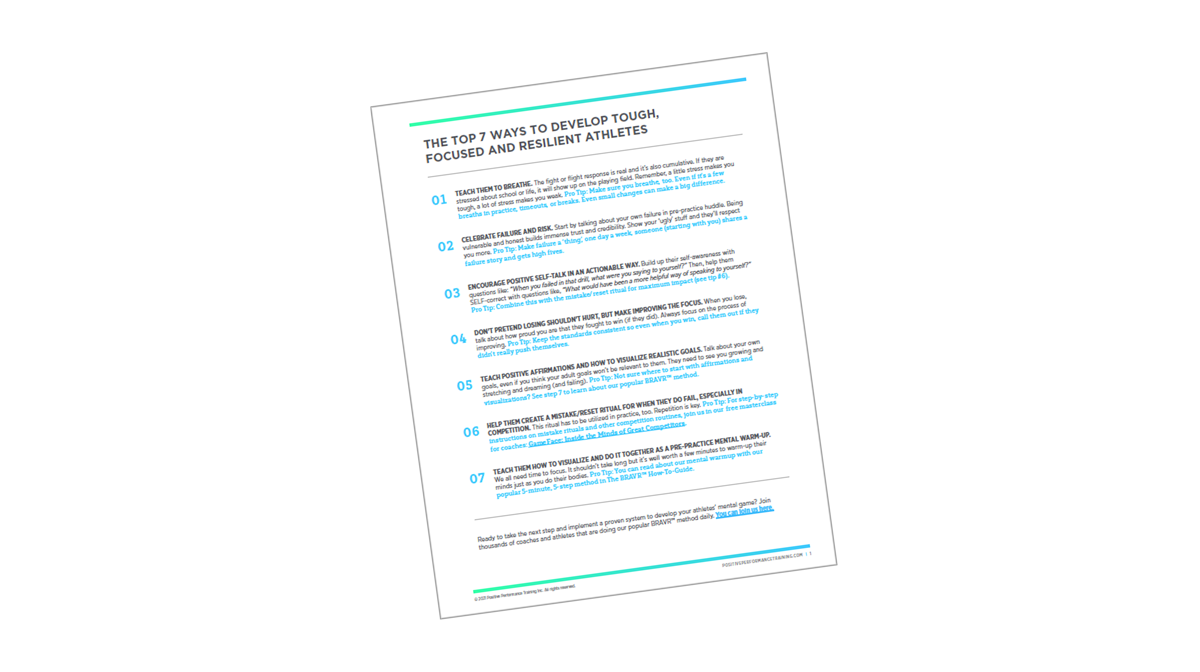Embracing failure: The clumsy, embarrassing (and usually ugly) path to success
Mar 31, 2016
A guest blog, By Tyson Hartnett
It was my first game on my high school's varsity basketball team. I was a rising junior and the starting point guard after being on the JV team the season before. What do you know, my first game is against a crazy-athletic team that full-court pressed the entire game. Great, I thought. Just great. As the point guard, it was my responsibility to catch the ball and organize our attack against the full-court pressure.
At that moment (after my fourth straight turnover), I wanted nothing more than to hide and never touch the ball again. I was humiliated and embarrassed. But, even more so, I was scared. I was afraid that if I got the ball, I would fail yet again.
Clearly, it wasn't going very well.
At that moment (after my fourth straight turnover), I wanted nothing more than to hide and never touch the ball again. I was humiliated and embarrassed. But, even more so, I was scared. I was afraid that if I got the ball, I would fail yet again.
But, I had no choice. I was the point guard, and it was my responsibility. So I reluctantly caught the ball, and (for the fifth time) faced the menacing sight of 5 longer, faster, more athletic players who could seemingly smell my fear. On that fifth try, I made it. I don't remember exactly how, but I wriggled my way through defenders, passed half-court, and initiated our half-court offense. Phew!
Why does this memory make me smile?
Even though we lost that game by 40 points, thinking about it brings up positive memories. Not because I enjoyed getting demolished, but because of how much I learned. I vividly remember the lessons my (epic) failure taught me. Namely, when you're attacking full-court pressure against better athletes, fewer dribbles is better than more.
It's a lesson that’s stuck with me throughout my collegiate and professional career, where I’ve faced better athletes on a regular basis.
Our most powerful lessons emerge from our biggest failures
Why did this lesson leave a powerful, lasting impression, while many others have faded away? Because I failed. Miserably. That failure was ten times more impactful than any coach simply telling me the same advice. In that moment, I was overwhelmed with fear of failure and embarrassment, but I still got back up (reluctantly, I’ll admit) and faced the likelihood of failure again.
Why is fear of failure so harmful?
It prevents you from stepping outside your comfort zone.
One way to ensure you don't reach your potential is to simply stay where you're comfortable. This is where most of the population lives. As athletes, this tendency is incredibly detrimental to growth.
Not only does it limit your ability to develop new skills, but fear of failure also perpetuates fear of the unknown. The longer you're cooped up in your comfort zone, the more daunting the outside world becomes.
You play not to lose.
Fear of failure compels players to set goals to avoid negative outcomes rather than achieve positive ones. Research has repeatedly shown that these types of goals, known as ‘avoidance goals’, are correlated with poor performance (Hulleman, Schrager, Bodmann, & Harackiewicz, 2010) and procrastination.
But wait, there’s more bad news. People who adopt avoidance goals have decreased satisfaction (Park, Dyne & Ilgen, 2012), lower self-esteem, and reduced optimism (Coats, Janoff-Bulman & Alpert, 1996).
Here's the takeaway: Striving for achievement (rather than working to avoid failure) leads to better outcomes.
Think about your greatest performances. My guess is you were playing loose and were completely focused on the task at hand, not worried about what would happen if you didn’t succeed. This achievement mindset is where great performances reside.
You hide your mistakes.
Hiding your mistakes impedes learning. This is incredibly harmful because learning and reflecting on mistakes is one of the most effective ways to improve. Research by Daniel Coyle (author of “The Talent Code” and “The Little Book of Talent”) suggests that one of the most important factors in realizing your full potential is to analyze your mistakes.
In that instant after you make a mistake, you have 2 choices: To ignore your mistake, or to pay deeper attention to your error. When you’re overwhelmed by a fear of failure, you’re more likely to wince and look away from your mistake, rather than ask yourself how you can learn from it.
It's not as fun!
No scientific support needed for this one. There's nothing more exhilarating than attacking a goal with unbridled optimism and enthusiasm.
You can't backpedal into success.
Success doesn't happen by accident. It comes through learning from failure, and putting purposeful work and effort toward a specific goal.
Research shows that simply adopting a ‘goal-approach mindset’ (where you aim to achieve success rather than avoid failure) is an effective way to improve performance (Lochbaum & Gottardy, 2013).
How can we minimize this fear of failure?
Answer: By fully embracing it as part of the learning process.
When I faced that terrifying full-court press for the fifth time, I reluctantly accepted the possibility of failure. But you can do better. You have the strength to search it out and welcome failure with open arms.
Failure not only helps you achieve success, it's a prerequisite to success.
5 Strategies for confronting your fear
It’s easy to say we’re going to embrace fear, but how do we actually do it? Here are some tactics you can try out.
Identify the root cause.
What is causing your fear of failure to be so pervasive? Did you experience a past failure that's lurking in your mind? Are you afraid of what your teammates/parents/friends will think of you if you fail?
In high school, my fear of failure stemmed from not wanting to be embarrassed. So, when I turned the ball over 4 straight times, I physically felt the fans’ judgmental stares.
Take a few minutes, sit down by yourself and do some self-analysis. I recommend taking out a piece of paper and just start writing. What you write doesn't have to make sense, flow, or even be grammatically correct. Just start with your fear, and write whatever comes to mind. You might be surprised at where your mind wanders.
Play the "what if" game.
What's the worst case scenario? This may seem counterintuitive, but the vast majority of our fears are either greatly exaggerated or not founded in reality.
[bctt tweet="The majority of fears are either greatly exaggerated or not founded in reality. Let go! Fear holds you back!. "]
If you were to miss 2 free throws with the game on the line, what's the worst that would happen? Maybe your coach gets mad at you, your teammates get pissed off, or your friends make a few jokes at your expense. But here's the thing: It's temporary! Which, brings me to my next point...
Remind yourself that failure is temporary.
"Failure is delay, not defeat. It is a temporary detour, not a dead end." -Denis Waitley
There are thousands of stories of people who overcame seemingly massive failures to achieve greatness. Probably the most famous one is the story of a young Michael Jordan being cut from his high school basketball team.
At the time, I bet MJ was crushed. Many of us have had that same feeling. Despite this failure, which probably seemed overwhelming at the time, MJ chose to work even harder and attack his goals with even greater conviction. MJ used his failure to inspire his success, rather than deter him from pursuing his passion.
So when you feel the fear of failure stir inside you, take a moment and repeat to yourself “Failure is temporary.” Even if your worst fears come to fruition, know that they will eventually fade, and (in time) turn into powerful learning experiences.
Visualize yourself going through life in two distinct ways.
All it takes is 5 minutes. Here’s how it works: Imagine your life in two future scenarios. First, imagine your life if you let fear dictate your choices. Second, imagine your life if you embrace failure. For each scenario, imagine not only the outcomes, but also the feelings and emotions you have.
For example, at each decision point (i.e. choosing to shoot free throws with confidence or asking that special someone on a date), how do you feel afterward? How does your life change as a result? Are you happy, energized, and filled with purpose? Or are you left feeling reactive and anxious?
If you decided to live your life confined by fear, what regrets would you have?
Just taking a few minutes to consciously think about it can do a lot to put fear of failure in perspective.
Take action!
For many of us, fear of failure is paralyzing. So take it one step at a time. Pick a single, tiny action that confronts one specific fear. Don't try to overcome everything at once. You may be surprised to discover that overcoming your fear, one small step at a time, makes the bigger goal feel a lot more manageable.
Don't wait for the perfect moment, or the most ideal circumstances. Do it now! While everyone else is standing on the sideline, you'll be learning, growing, and doing.
BONUS: Keep this great quote in mind:
“The few who do are the envy of the many who only watch.” - Jim Rohn
Resources Coats, E., Janoff-Bulman, R., & Alpert, N. (1996). Approach versus avoidance goals: Differences in self-evaluation and well-being. Personality and Social Psychology Bulletin, 22, 1057-1067. Hulleman CS, Schrager SM, Bodmann SM, & Harackiewicz J. A meta-analytic review of achievement goal measures: different labels for the same constructs or different constructs with similar labels? Psychol Bull. 2010 May; 136(3):422-49. Lochbaum M., Gottardy, J. A meta-analytic review of the approach-avoidance achievement goals and performance relationship in the sport psychology literature. J Sport Health Sci 2015;4:164-173. Park, G., L. Van Dyne, and D. Ilgen. 2012. Satisfaction pursuing approach and avoidance goals: Effects of regulatory fir and individual temperaments. Motivation and Emotion (forthcoming)
Ready to start training the mental game?
Get your FREE copy of the Coaches Cheat Sheet: Top 7 Ways to Develop Tough, Focused, Resilient Athletes!
The Coaches Cheat Sheet uses visualization, positive self-talk, breathing, and mindfulness to help coaches get their athletes’ head in the game once and for all.
This is simple enough to be a great starting point for coaches who want to begin mental training their team, and robust enough to be a great addition to any existing mental training program.
Get your free copy here!
Join Our Community Of 10,000+ Coaches
Dive deep into the world of mindset coaching. Our no-frills, tough-love advice, easy-to-implement guides, and insightful blogs are specifically designed to help you and those you lead to tap into your next level.





